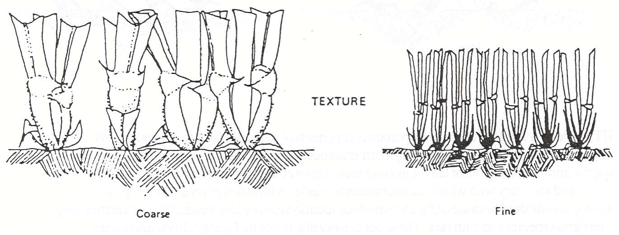This is the 4th part in a series of short articles which aims to give you the tools to make a performance evaluation of your bowling green. You can access the previous articles in this series are as follows:
Part 1. The Performance Evaluation of the Bowling Green
Texture
Today we’ll look at Turf Grass Texture.
Texture in this respect refers simply to the width of the individual leaves in the sward or more importantly the general or average width. Again, at this stage of our appraisal we are making a largely visual judgment although this aspect can be measured more precisely if you have the time or the inclination.
The preferred texture for fine turf playing surfaces like bowling greens is a medium-fine to medium texture, ranging from 1.5 to 3 mm in width. In un-mown swards, the grass plant leaves will tend to broaden with age and you might be surprised to see just how different, say a bentgrass plant will look when left to grow naturally as compared to a closely mown plant on a bowling green. It’s an experiment you can easily try by planting some seed in a pot.
Different species vary widely in leaf texture and there can even be a considerable variability within one turf grass species, but the main influencing factors are the cultural practices we employ such as mowing height, nutritional level and particularly mowing frequency. For example the leaf texture of creeping bentgrass and annual meadow grass can be reduced 50% by lowering the height of cut from 37.5 mm to 7.5 mm.
Although Annual Meadow Grass (amg) remains undesirable in fine turf surfaces, where it dominates the sward already, many greenkeepers maintain a very fine surface consisting mainly of amg. This is achieved over a long period of time as the amg adapts to take advantage of the prevailing conditions imposed by the greenkeeper. These greens can, however, suffer badly in adverse conditions and look terrible out of the main growing season.
Although it is desirable to allow the green to grow on a little in winter, it is not beneficial to maintain a mowing height much above 8mm, as the texture can start to broaden significantly and of course other issues with soil surface micro-climates in longer grass can occur leading to increased disease outbreaks etc.
Turf Density and Texture are closely related features of a fine turf grass. As density increases, texture becomes finer. And of course, as texture (leaf width) becomes finer, the possibility of a higher turf density is introduced.
That’s it for today, so you now have a new aspect of your turf to examine. I hope by now you can see the start of some connections between the features we’ve been evaluating. I hope too that you will see the benefits from making a performance appraisal of your bowling green turf. Everything we have looked at so far can be combined and an appraisal undertaken and recorded in minutes, so it’s a useful habit to get into. The improvements over time will then be documented and you will have an understanding of the why as well as the how of Performance Bowling Greens.
Next time, although we are staying with the general theme of Performance Evaluation, we will break into a bit of turfgrass anatomy to try to explain some of the science behind the aspects of turf performance we have studied so far.
Have a go at appraising the texture of your grass and try to compare it with the grass around the grounds or gardens to see the adaptive ability of grass and the potential you have to influence its appearance, functionality and performance.

